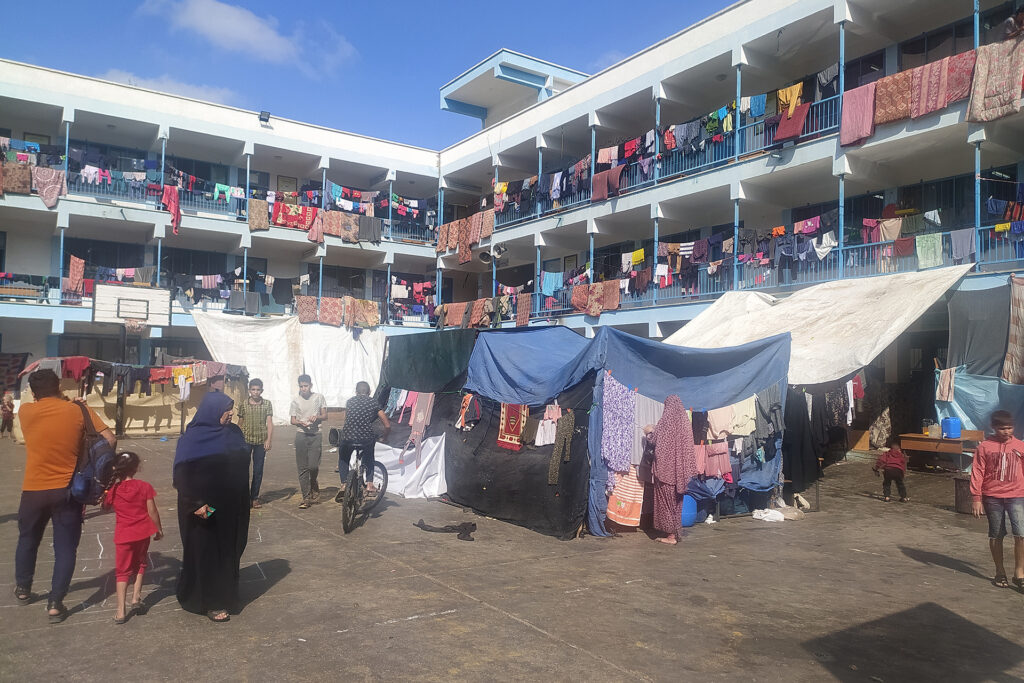Tel Aviv Tribune Net correspondents
Gaza – The word “and two dimensions”, which is popularly used to refer to a blocked horizon and lack of options, haunted Ahmed Al-Amoudi while he was busy attaching pieces of old plastic to wooden poles to set up a tent in the middle of the courtyard of a shelter center in a school affiliated with the United Nations Relief and Works Agency for Palestine Refugees (UNRWA) west of the city of Rafah, south of Rafah. Gaza strip.
Al-Amoudi did not find room for him in five shelter centers, so he set up a tent in a school yard, even though registration there was closed to new displaced people. He said, “Where will I take my family? The crowding in Rafah is like doomsday.”
Repeated displacement has exhausted Al-Amoudi (45 years old) and his family of 6 members, from the Nuseirat camp, where he was displaced – for the first time – from his home in the Al-Nasr neighborhood, north of Gaza City, to his friend’s house in the Al-Qarara area, east of Khan Yunis, in the south of the Gaza Strip, and from there to Nasser Hospital. Government center west of the city, then to a shelter center in Rafah.
Speaking to Tel Aviv Tribune Net, Al-Amoudi expressed his wish that his next move would not be a new displacement, but rather a return to his home, saying, “By God, we are tired and the world is watching us die from missiles and diseases.”
A stricken city
In response to successive waves of displacement, the Emergency Committee in the city of Rafah directed the displaced towards the Hamad Hospital buildings under construction in the west of the city, while the city’s Endowments Directorate decided to open mosques to women, children and the elderly.
UNRWA fears what it described as “a more terrifying scenario,” and according to its media advisor, Adnan Abu Hasna, intestinal diseases have increased by a rate of four times, skin diseases have increased by a rate of three times, and about 170,000 children are suffering from lung infections, reiterating the warning that “infectious diseases are on the rise.” “It’s about to spread.”
In turn, the head of the Health Emergency Committee in Rafah, Dr. Marwan Al-Hams, summarized the reality of the situation by saying that “the situation is distressing,” adding that “Rafah is a disaster-stricken city, and the severe crowding in schools, public facilities, and residential homes portends a health disaster, and we do not have the capabilities to confront this disaster.”
Al-Hams runs the largest Abu Youssef Al-Najjar Hospital in the city, and according to him, the hospital receives double numbers of cases of diarrhea, high temperatures, and severe fatigue, the largest percentage of which are among children and the elderly inside shelter centers, according to what he told Tel Aviv Tribune Net.
Many children and infants in shelter centers suffer from dehydration and anemia resulting from malnutrition, according to Al-Hams, who adds, “What is coming is worse unless the Rafah crossing is opened permanently and a daily flow of aid and basic humanitarian needs is guaranteed, including relief and medical supplies, as well as the necessary fuel.” To operate vital facilities.
Cholera rears its head
Dr. Muhammad Madi deals daily with dozens of cases that Al-Hams spoke about, and he tells Al-Jazeera Net that “the reality is tragic, and we deal with these cases empty-handed and without the most basic medical ingredients.”
Madi was displaced from Al-Rantisi Hospital for Oncology and Children’s Cancers in Gaza City, and resides with his family in a shelter center at Al-Quds Governmental Secondary School in the city of Rafah. He said that the spread of more deadly diseases and epidemics on a large scale is not unlikely, such as cholera and hepatitis, due to the lack of Sanitary facilities, proper nutrition and safe drinking water.
Madi and his fellow displaced people volunteered to open a “medical point” inside the shelter center, explaining that the displaced people live in a “fertile environment for the spread of diseases,” with severe crowding in rooms and courtyards, causing skin diseases, intestinal infections, and chest infections.
To ensure the continued operation of this medical point, Madi is forced to wander between hospitals and health centers to obtain some medicines and initial treatments.

Exodus into the unknown
In a related context, UNRWA media advisor Adnan Abu Hasna said that hundreds of displaced families are now in the streets at the gates of shelter centers, where there is no place for them, with there being about 1.2 million displaced people in 156 shelter centers across the Strip, and more cannot be accommodated.
Among these displaced people, about one million displaced people took refuge in 99 UNRWA schools and facilities in the central areas of the Gaza Strip and the cities of Rafah and Khan Yunis in the southern Gaza Strip. According to the UN agency, the average number of displaced people in its centers is 10,326 displaced people, which is more than 4 times their capacity. .
UNRWA and other international organizations estimate the total number of displaced people at about 1,900,000 Palestinians, representing 85% of the total population of the Strip, whose number exceeds 2.2 million people. These displaced persons are distributed among shelter centers and in the homes of relatives and friends.

